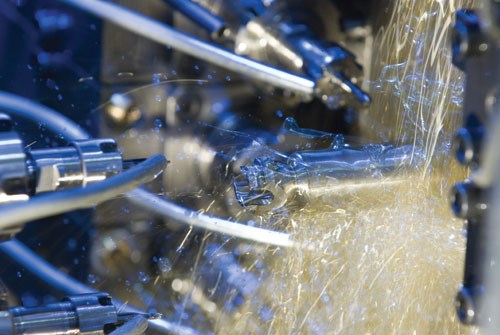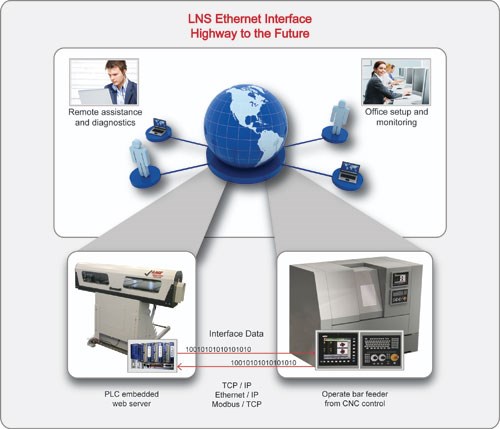Bar Feeders Provide New Paths to Productivity
The lastest advances in bar feeding can help you prepare for the coming manufacturing resurgence.
From all reports, inventories of finished goods will soon be at an all-time low. This means that when the long winter of our economic discontent ends, pent up demand will push manufacturers to ramp up production.
As always, those shops that can respond quickly and with more cost efficiencies will have a decided advantage over their competitors. To achieve this, forward thinking operations will use the current downtime to enhance their manufacturing processes by investing in the newest generation of automation products, including bar feeders.
The obvious reasons to couple bar feeding systems with CNC machine tools are to reduce the cost of making parts, increase output and reduce time-to-market. Regardless of the ups and downs of the economy, these fundamental concerns haven’t changed since bar feeders first gained popularity more than 30 years ago. What is continuously changing is the way in which bar feeding systems deliver these benefits.
Continuous Development
There have been a number of significant technological advancements in bar feeding throughout the years, beginning with the introduction of the hydrodynamic system, pioneered by LNS, that uses oil within the guide tube to support a 12-foot length of barstock and enable vibration-free turning at higher spindle speeds. Additional bar feeder innovations followed, including fully automatic bar feeders, “short-loaders” for spindle length barstock that require no guide tubes or oil, servomotors for better control and faster change-overs, and many other refinements.
The latest productivity-enhancing bar feeder innovation builds on these operational developments by improving the interaction between the bar loaders and the CNC turning machines or the multi-station machining centers they serve. For example, LNS recently introduced the first Advanced Ethernet Interface (AEI) for this purpose.
Although the initial thought was to reduce interface costs and make change-overs quicker and easier, it soon became apparent that the interface could improve productivity in a multitude of ways. Working with the leading CNC machine tool OEMs, and using input from many end users, AEI is evolving into a multi-faceted communication system.
More Flexibility
A key benefit of this communications interface is the ability to more efficiently complete a high mix of long or short production runs, a complex family of parts and even a variety of unrelated parts with little or no operator intervention. Here’s how it works: The operator programs the machine tool for the series of runs to be performed. As each job is ready to begin, the machine’s controller selects the correct tooling from an automatic tool changer (ATC) and uses the AEI to inform the bar feeder of the new job parameters.
On command from the machine tool CNC, the bar feeder then performs any adjustments for such factors as part length and pusher travel that are necessary to accommodate the job. All of these adjustments are performed automatically on select bar feeder models. This enables the machine tool to move seamlessly from one job to another without operator assistance.
In addition to time and labor savings, this communication system can also save materials costs through a unique Library Search feature. For example, if the machine tool finishes machining parts from a length of barstock and the bar remnant is too small for the machine to make another of the same part, the system can electronically search a parts program library to find another part that can be machined from the remnant now in the machine tool. The machine tool then communicates to the bar feeder, the change-over is automatically made, and the new part is machined.
Impact on Untended Operation
Clearly, the advantages of the AEI are well suited to lights-out production. With no operator interaction required, a shop can set up a series of jobs at close of day and find the finished parts in the morning.
However, some shops resist untended operations for fear that something will go wrong, especially over a weekend or holiday shutdown. Because the AEI is Internet-enabled, the process is easily monitored remotely from any computer that has Internet access. It can even be set up to send alerts to a mobile phone if the system is forced to shut down or needs attention.
Connectivity with Other Peripherals
The AEI also has the potential to open communications between the machine tool and other LNS components used in an automation process. One scenario might include the machine tool, the bar feeder, a high-pressure coolant system or a vacuum unloader. As each job comes up in the machine tool’s program, the AEI tells the bar feeder to make the necessary adjustments, the high-pressure system to adjust its stream and the unloader to prepare to accept parts.
Throughout the past 30 years, bar feeders have evolved from simple machines that load barstock into devices that use sophisticated technologies to enable more precise, cost-effective and safer parts production. The next step, exemplified by the LNS AEI, is the ability to seamlessly interface with machine tools and other automation components. By so doing, machine shops of any size will be better able to respond to the next great manufacturing run.
Related Content
Bar Feeder Offers Simple, Fast, Silent Automation
PMTS 2023: Bucci Industries’ Next 25 bar feeder offers high rotational speeds (more than 10,000 rpm) and fast, unattended bar changes with high indexing and silent performance.
Read MoreBar Feeder for Sliding Headstock Lathes Enables Higher RPMs
PMTS 2023: The LNS GT 342 automatic magazine bar feeder is designed to enable fast and easy diameter changeovers and improved productivity.
Read MoreRead Next
A Tooling Workshop Worth a Visit
Marubeni Citizen-Cincom’s tooling and accessory workshop offers a chance to learn more about ancillary devices that can boost machining efficiency and capability.
Read MoreEmerging Leaders Nominations Now Open
Here’s your chance to highlight a young person in your manufacturing business who is on the path to be a future leader moving your company forward.
Read MoreDo You Have Single Points of Failure?
Plans need to be in place before a catastrophic event occurs.
Read More

















.png;maxWidth=300;quality=90)





